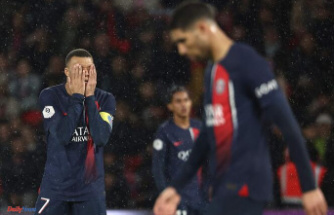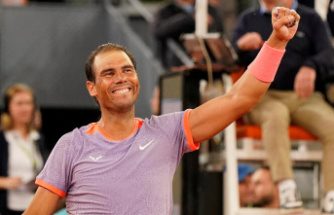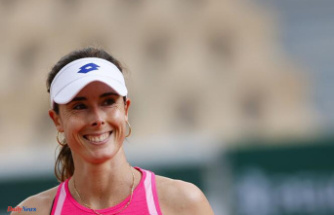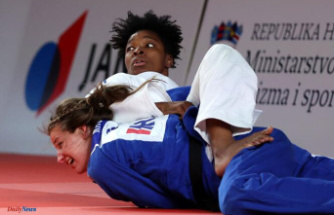Rafael Nadal only needs two more wins to also win the Grand Slam tournament in Wimbledon. But an injury forces him to retire before the semifinals. An amazing decision by the Spaniard, who has a vague relationship with pain.
Everything was actually ready for Rafael Nadal's tens of thousands of heroic stories. The Spaniard, who has been fighting with unbridled passion for two decades and whose body is his greatest opponent, played his way into the semi-finals of the Wimbledon grass classic with an absurd pain marathon against the American giant Taylor Fritz. Two more wins were needed and the proud Majorcan would have won the third major tournament of the year after the Australian Open and the French Open. Another title at the US Open and men's tennis would have been gifted a historic moment, the first Grand Slam in over half a century, the first Grand Slam since Rod Laver in 1969.
But this does not occur. Nadal hoisted the white flag before the showdown with the always yelling Nick Kyrgios. The rupture of an abdominal muscle was so painful that continuing to play was not an option. With probably any other player on the tour, one would not be surprised that an injury would have such a consequence. Not so with Nadal. As passionately as the 36-year-old crushes his opponents on the pitch, he's also tough on the wear and tear on his body. 21 years as a professional have pushed him physically to the limit, also because he never spared himself, always played at the limit. His games were a pleasure for the audience. Torment for his bones, joints, tendons and muscles. Nadal ignored them, stunned them.
And even now he doesn't take a break. He wants to be back on the field and training as early as next week. "Playing from the baseline shouldn't be a big deal," says Nadal. He certainly couldn't pitch for a while. "The positive thing is that I can train further from the baseline. That will help me keep to my tournament schedule the way I want to." The Spaniard's mind is his body's greatest enemy. Success proves him right. However, the means are anything but sacred. The 36-year-old has a strange relationship with taking painkillers, even for professional athletes.
It became a big topic after his success at the French Open. In several interviews he had confessed how difficult it is for him to do his job, which is also his great passion. "I was playing with a numb foot, the nerves were blocked," he confessed. Before every duel he had injections to treat his chronic ailments. A madness. After all, he himself saw that this approach cannot be a permanent solution. As early as 2005, Nadal was diagnosed with Müller-Weiss syndrome, a degenerative bone disease in which the scaphoid deforms or regresses over time. This syndrome has affected the 36-year-old again and again.
After the 14th triumph in Roland Garros, it suddenly seemed completely open whether Nadal could continue his career. If he would actually return to his holy place as a professional athlete. The Spaniard placed all his hopes in a new therapy ("radio frequency injection") - and it apparently worked. Before starting Wimbledon, he had reported that the chronic pain in his left foot had eased. The affected nerves were numbed with the new treatment method and can no longer transmit the pain stimulus to the brain. But now the next strike of his body. Nadal says: "The most important thing for me is luck, not titles, even if everyone knows what I did to get here. I can't risk being completely out for two or three months."
Sentences that are not easily believed from him. Because he pumps himself up for his job. As with his five-set thriller in the quarterfinals against Fritz. He was given anti-inflammatory drugs and painkillers on court. A dangerous vicious circle. Anyone who no longer perceives the pain does not feel when it is too much for the body. The athlete risks an even more serious injury, possibly damage that can no longer be treated. The drugs also have side effects. But in addition to the risk to yourself, the immense consumption of painkillers had recently triggered a moral discussion.
Ernst König, head of Swiss Sport Integrity, formerly Switzerland's anti-doping agency, told the "Tagesanzeiger": "If it becomes chronic, it becomes problematic. The question arises: is this the sport we want? Which one You send out a signal to young athletes? What do you tell them if they are in a similar situation? Of course, they also want painkillers." Nadal's method is of course allowed, at the same time König explained: "We try to tell the young athletes: Listen to your body. We consider the attitude of throwing in a powder when you have trained too much to be fatal. It would be better for the body to take a break."
The doping expert and pharmacologist Fritz Sörgel sees it this way: "A local anesthetic with vitamins and everything else that is injected is of course doping by its nature, that's clear," he told the NDR a few weeks ago about the case Nadal. Because it puts the athlete in a position to do something that he or she couldn't do otherwise. "But it's quite difficult to get that into the WADA code because they can't forbid a person to numb their pain with a painkiller."
The French cycling stars Guillaume Martin and Thibaut Pinot had previously been critical. People would admire athletes like Nadal, what they can achieve despite pain. "But the fact is that they use substances to get that far. That's very borderline," Martin complained, judging: "Tennis has similar requirements to cycling. It's an endurance sport with acceleration, so I think the same Means also have a doping effect." Pinot confessed: Nadal's treatment was "simply forbidden" in his sport. According to his own statement, he lost two years of his career due to injuries because - unlike Nadal - he couldn't get fit injections. However, this runs like a red thread through the career of the tennis star. Again and again there were reports about sometimes controversial methods of treatment. Almost eight years ago, a stem cell treatment caused a stir. This was even forbidden in some countries. Once again, doping allegations were made. Also something that accompanies Nadal.
Now he decides to leave the path of stunning for the time being. He had "thought about the decision all day," he said on Thursday. "There's no point in playing if I want to continue my career." And he wants that. Nadal expects a tournament break of around three to four weeks. That would see him return in time for the US Open, which begins in New York at the end of August. It's not a heroic story...












